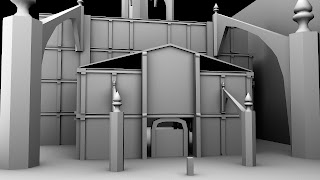Above is the basic sketch how I want the level to be constructed. Quite simply the player will have just entered the doors of the church and the main focus point will be a stain glass window at the back. The player will then have to navigate through a maze-like level. From my research in Colour Harmony's these will be experimented with using those colours but for the lights that will be placed through-out the level.
Using traditional methods (colour harmony's) and lighting techniques (Film Noire) will player's be able to make through the level quicker based on the setups that I have done? There will probably 3 iterations of the level so It's important that the levels can be re-built in different ways quickly and efficiently.
Below I have constructed a church structure in a Modular fashion this means that when I bring each object in UDK they will snap to the grid nicely and also can be re-arranged quickly. Luckily the way in which this have been constructed there is roughly 15-20 meshes that make up this entire structure. With the added furniture like benches cabinets and probably more architectural detail maybe make that between 35-40 meshes.
I will be using UV Master (Zbrush plugin) to quickly UV map meshes and then finally texturing them. This will take quite a bit of time but I aim to get the main object UV'd and textured. The colour of lights is what shall give the level(s) it's final touch.
I don't even think the front end will be added It's too time consuming to add all of it but at least its there if it needs to be used. The small cube in each picture is the exact size of a player in UDK so there is a lot of room for the player to run about.
Front Entrance.
Main Interior.




















































